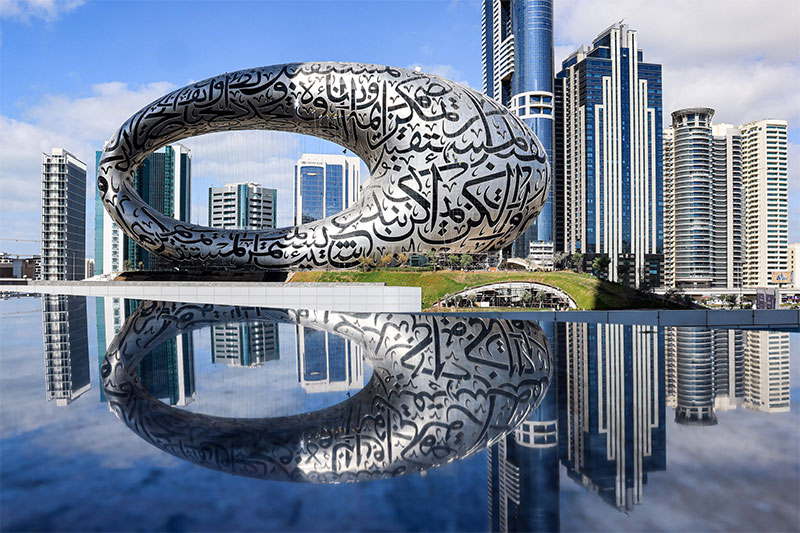An architectural wonder known as one of the most beautiful structures in the world, the Museum of the Future, towers over Dubai’s driverless metro system. The circular, hollow, seven-story skyscraper with no pillars and a massive steel facade is perched atop a hill that resembles a lawn. You will be greeted by a sizable room as soon as you enter the museum, where sunlight streaming from the Arabic calligraphy carved on the front creates a fusion of light. The museum is vibrant, inventive, and dynamic, and a visit there will provide you with some priceless memories.
On February 22, 2022, the Museum of the Future, or MOTF, was formally inaugurated. Since the start of the construction in 2015, residents of Dubai have witnessed its advancement. This year saw the official opening of the museum, which now hosts a few standalone exhibits. Daily hours of operation for the museum are 10 am to 6 pm.

Museum of the Future design and architecture
The Museum of the Future, built as an asymmetric torus covered in steel and glass, has been named one of National Geographic’s top 14 most beautiful museums in the world. It’s a tribute to the building’s designer, Shaun Killa, who intended it to embody Dubai’s vision for the future.
The museum’s stunning front is made stand by the artistic usage of Arabic calligraphy, which also acts as glass windows. They were produced by Emirati artist Mattar bin Lahej and include inspirational poems by HH Sheikh Mohammed bin Rashid Al Maktoum, Vice President and Prime Minister of the UAE and Ruler of Dubai.
What to expect at the Museum of the Future
The groundbreaking construction, which will serve as a portal to the world in 50 years, will show how next-generation solutions, like augmented reality and artificial intelligence, may improve our quality of life while also strengthening the global economy.
Visitors will have the opportunity to interact with this cutting-edge technology. Each floor of the museum was designed as a sizable interactive set that was brought to life by creative storytellers, technologists, and forward-thinking artists. Future living in space, ecological concerns, and climate change, as well as health, happiness, and spirituality, are some of the topics being discussed. There will be ground-breaking discoveries along with special workshops and talks by the world’s foremost intellectuals.
Children between the ages of three and ten can engage in an open-world experience in the Future Heroes environment, a unique location designed to encourage children to achieve their potential.
Visitors should also stop by the viewing deck on level two, which is tucked away inside the museum’s “void” and offers panoramic views of Dubai’s bustling metropolitan core in addition to an up-close look at the facade’s smooth interior. Free entrance is offered to Emirati seniors, persons over the age of 60, and children under three. Tickets cost AED145 and can be purchased on the official website.

Museum of the Future | Quick Facts
- Official name: Museum of the Future
- Location: Sheikh Zayed Road, Trade Centre, Trade Centre 2, Dubai, United Arab Emirates.
- Announcement: 4 March 2015.
- Date of opening: 22 February 2022
- Features: 7-story exhibition space, 3 podium levels, a 420-seat auditorium, cafeteria, lobby, etc.
- Design Fact: Stainless steel face engraved with Arabic calligraphy.
- Awards: Tekla International Building Award, ‘Most beautiful building’ title from National Geographic, etc.
Why is the Museum of the Future So Famous?
- The MOTF is different from other museums across the world since it is a project of the Dubai Future Foundation or DFF. To give you a glimpse into the future, the museum makes use of augmented reality, virtual reality, and other cutting-edge technologies.
- It is one of the city’s low-carbon constructions and is LEED-certified.
- Arabic calligraphy is carved on the museum’s surfaces, giving the space an ethereal radiance. Sheikh Mohammed, the ruler of Dubai, was the source of the poetry used in the calligraphy.
- You get the opportunity to consider the fate of both humans and nature in general inside the museum.

